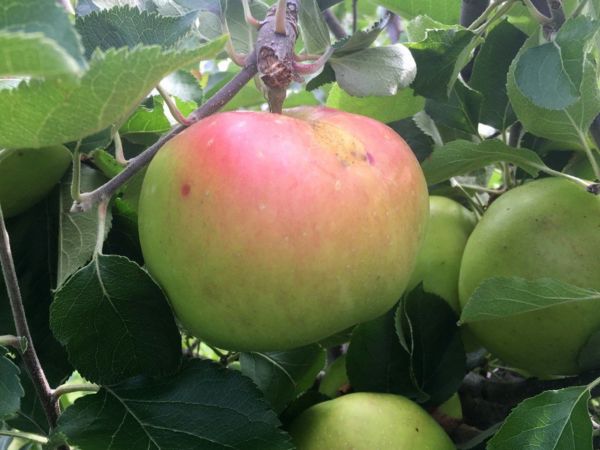An attractive, highly disease-resistant apple, ideal for organic growers.
Bramley's Seedling Apple Scionwood (Spring 2024)
A highly acidic heirloom baking apple treasured in British cooking. Also known as Bramley, Bramley's, Bramleys.
Bramley's, or "Bramley" produces a vigorous, spreading tree that is highly resistant to apple scab. It is a heavy and regular cropper, ripening in early to mid-October in upstate NY, and it is also a partial tip bearer. As a triploid Bramley should not be used as a pollenizer, and it will require two diploid trees for full fertility. Although it is hardy to zone 4, the buds and blossoms are rather frost susceptible and it will have greater success when cultivated in zones 5 and higher.
In 1809 a young woman named Mary Brailford planted a handful of apple seeds, one of which thrived and grew into the first Bramley tree. The fruit produced by this tree was a huge, flattish green apple streaked with red, which by 1900 had become a favorite culinary apple in Britain and Ireland. The thick skin gives way to firm, juicy, creamy yellow flesh. In contrast to Calville Blanc (the culinary apple of France), Bramley is valued for the melting, binding quality of its flesh when cooked down. The resulting pulp is fluffy and light, and it has an outstanding tangy flavor. Although the juice is somewhat one dimensional, the high acid content also lends itself to cider blending. Bramley stores well, but it does tend to develop an unappealing greasy skin quite quickly. (From WSU: Tannin (percent tannic acid): 0.09; Acid (percent malic acid): 0.11; pH: 3.12; SG: 1.045; oBrix 11.2.)
The original tree that Mary planted was blown over by a storm in the early 1900s, but fortunately a branch took root and survived. The tree can be seen at 75 Church Street, Southwell, Nottingham, where an annual Bramley Apple Festival is celebrated every October. Bramley apples from County Armagh in Ireland have been granted Protected Geographical Indication status within the European Union.
Volume Pricing
| Quantity | Bramley's Seedling Apple Scion |
|---|---|
| 1 | $12.00 |
| 2-5 | $7.00 |
| 6-10 | $6.00 |
| 11-99 | $5.00 |
| 100+ | $4.00 |
The Fruit
Fruit Type
Category: Apple
Subcategory:
Heirloom, Cider, Disease-Resistant, Cold-Hardy
Fruit Uses & Storage
Uses: fresh eating, cider, baking, storage, jelly
Cider classification: sharp
Storage duration: three plus months (approximate, depending on storage conditions)
Fruit Appearance
Skin color: green
Flesh color: white
Fruit Origins
Parentage: unknown
Origin: Nottinghamshire, England
Introduced in: 1809
Introduced by: Mary Brailsford
The Environment
Calendar & Geography
USDA zones: 4 - 7
Chill hours: 1000
Ripening date: Sep 15 (approximate, in New York State) + 0 days after McIntosh
Diseases & Pests
glossary
Apple Scab: Very Resistant
Cedar-Apple Rust: Resistant
Fireblight: Resistant
Powdery Mildew: Resistant
Pollination
Pollination Factors
glossary
Bloom group: 2
Is it self-fertile? N
Is it fertile? N
Ploidy: Triploid
Pollination Partners
This table shows the first few results from a full search for pollenizers of Bramley's Seedling Apple. Please see our Pollenizer Search to run other queries and read how the application uses various factors. Also read more about fruit tree pollination.
| Tree | Currently in Stock |
|---|---|
| Florina Apple | 0 |
| Porter's Perfection Apple | 0 |
| Spitzenburg Esopus Apple | 0 |
| Virginia Crab Apple | 0 |
| Binet Rouge Apple | 0 |
| Rubinette Apple | 0 |
| Bramtot Apple | 0 |
| Mother Apple | 0 |
| Muscadet De Dieppe Apple | 0 |
| Kingston Black Apple | 0 |
| Melrose Apple | 0 |
See all pollination matches for Bramley's Seedling Apple
Featured Products
A few things we're loving right now...
A full-flavored, freestone white peach.
One of America's oldest apples, good for storage, baking, and cider.
A widely-grown, large, yellow-fleshed nectarine.






















